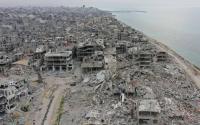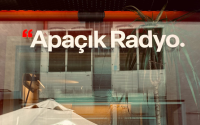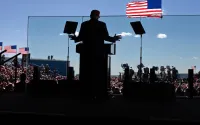26 September, 2002By Sudhanva Deshpande
On the evening of Tuesday, 24 September 2002, thirteen days after 9/11, armed militants stormed into the Swaminarayan temple in Gandhinagar, the capital of the western Indian state of Gujarat, and opened fire on Hindu devotees gathered there for evening prayers. The firing went on all night, and at least three militants have reportedly been killed. A fourth militant is suspected to be inside the temple, probably still alive.
It is not yet known who these militants are, but suspicion rests on the two Pakistan-based jehadi groups operating in Kashmir, Lashkar-i-Toiba and Jaish-i-Muhammad. The attack has come on the evening of the second day of the four-phase polling in the state of Jammu and Kashmir. In the first phase, according to the figures given by the Election Commission of India, the polling was an unexpectedly high 44 per cent and the second phase saw polling at 42 per cent.
As I write this commentary on the morning of 25 September, it is still not certain what the eventual death toll in Gandhinagar will be. The morning news on television reported 34 dead, but some newspapers have claimed 44. With many dozen injured, it will not be surprising if the eventual toll is over 50. What is certain is that these 50 or more will not be the last victims of this attack.
A sinking feeling of foreboding and terror is inevitable. To be sure, most political parties in India have spoken in seemingly one voice, condemning the killing of innocents, pointing to the timing of the attack which coincides with the elections in Kashmir, appealing to people from all communities to keep calm and so on. The Home Minister of India, L.K. Advani, who represents the Gandhinagar constituency in Parliament, flew to the city late last evening to oversee operations. The Chief Minister of Gujarat, Narendra Modi, went on television last night expressing confidence that the people of Gujarat will not be provoked into retaliating.
Yet, it is difficult to believe that calm will indeed be maintained. As the dead and the injured were being taken to hospital, Hindu nationalist slogans were raised by the crowd gathered outside the temple. In the hospital itself, television news clips caught members of the fascist Rashtriya Swayamsevak Sangh (RSS) scurrying about. The Vishwa Hindu Parishad (VHP), a militant front of the RSS, has called for a strike today to protest the attack.
It is action replay time. Earlier in the year, the state of Gujarat was racked by communal violence which left, according to government figures, more than 2,000 dead. The unofficial estimates are at least twice as high. The vast majority of the dead were Muslims. The violence went on for more than 100 days. Over a hundred thousand, mostly Muslims, had to flee their houses and spend the cruel summer in relief camps in the most abysmal conditions. Those who tried to go back were often either chased away by Hindu militants, or had to accept humiliating conditions to reclaim their homes and livelihoods.
It is only in the past few weeks that the state was slowly beginning to limp back to normalcy. But this normalcy is fragile even without provocation of the kind we have seen yesterday. The violence in the state earlier in the year got called by that routine name everyone gives to periodic bursts of bloodletting and killing that punctuate the history of the subcontinent: riot. In reality, it was anything but that. Gujarat was a one-sided attack, a carnage. It was, to put it bluntly, a pogrom: "an organized, official persecution, for racial or religious reasons, which usually leads to mass killing of a group of people."
Nothing Muslim was spared. In a row of ten shops, uncannily, the only Muslim-owned shop would be looted and gutted. In a row of parked vehicles, only the Muslim-owned vehicle would be burnt. The precision was stunning. Mobs came armed with lists of addresses and names. Printed lists. Lists taken from the municipal records. Lists published earlier in local newspapers. Lists of Muslim properties, businesses, houses. This was not a riot.
The triggering off point for the pogrom was 27 February 2002, when bogies of the Sabarmati Express were set ablaze near the railway station at Godhra in Gujarat, claiming 59 lives. Those killed on that day, as yesterday, were Hindus. But those Hindus roasted alive in the railway compartments were not ordinary devotees as yesterday, they were volunteers of the right wing Hindu nationalist organizations who were returning from the temple town of Ayodhya in north India. It was in Ayodhya ten years ago, on 6 December 1992, that a medieval mosque was razed to the ground by Hindu fanatics on the plea that the mosque stood at the precise spot where the mythical king-god Ram was born.
For a long time before and since, the RSS and its affiliates have been demanding the construction of a Hindu temple on the spot, and the mobilization of volunteers early this year was to pressurize the government and the Indian Supreme Court to allow the construction. The Supreme Court refused to oblige. Within a fortnight, the killings at Godhra had taken place, which served as signal for Hindu militants to go on the rampage in the following weeks and months.
The pogrom was in the making for a long, long time. It was not a 'spontaneous reaction' to the atrocity at Godhra. No incident of communal bloodletting is ever spontaneous, of course. Killing is hard business. Nobody does it 'spontaneously'. The forces of the fascist Hindu right have been systematically spreading their poison for many years. Lists don't get extracted from municipal records just like that, in a moment of madness and fury. When policemen, far from stopping killer mobs, actually give covering fire to them, this is not a case of the proverbial 'official apathy'.
When bulldozers owned by the state are used to raze to the ground shops and houses and mosques and Muslim shrines, it is not 'official apathy'. When destroyed structures are tarred over and a road constructed on them to remove even a trace of what existed, it is not 'official apathy'. It is active collusion in murder and pogrom.
Presiding over this carnage was Chief Minister Narendra Modi of the Bharatiya Janata Party, which, apart from ruling in Gujarat, leads the coalition that rules at the centre in New Delhi. Modi is among the most hated figures in contemporary India, having become a symbol of fascist bigotry and intolerance. Even as the state was limping back to normalcy, demands were raised by a large number of people, including many opposition parties, for the resignation of Modi. He refused. His party brazenly defended him again and again. Among those who led his defence was Home Minister Advani, currently in Gandhinagar.
It is impossible, in this context, to take Advani and Modi's appeals for calm yesterday evening at face value. They have presided over what is amongst the worst communal carnages in independent India's history. They have, through their statements and actions, overtly and covertly, defended the killers, protected them, and punished those few government officials who dared to take the side of sanity and peace.
It is impossible also to believe that right wing Hindu organizations will themselves remain calm. Even as the demand for Modi's resignation was being aired, he decided to prematurely dissolve the state Legislative Assembly, which was due to complete its term early next year. His and his party's calculation was that the communally polarized atmosphere of the past months will ensure their return to power in the state. The displacement of a large number of Muslims into relief camps and elsewhere would also have helped, since it would have prevented them from voting. The decision to dissolve the Assembly was defended vociferously in Parliament by, among others, Home Minister Advani, who, only weeks later told the Western media that the events of Gujarat made him hang his head in shame.
The BJP gameplan of early elections in Gujarat misfired when the Election Commission of India decided that the situation was not yet back to normal, and thus elections could not be held immediately as desired by the Chief Minister.
In the meanwhile, secular forces - NGOs, human rights groups, left organizations and parties, cultural groups, etc., both inside Gujarat and elsewhere -besides mobilizing relief for the victims of the violence, were also mobilizing public opinion against the right wing Hindu agenda. Initially, their task appeared uphill, almost impossible. It seemed quite certain that Modi will lead the BJP to victory in the elections. That would have given organizations like the RSS and the VHP an even freer hand in Gujarat to unleash further experiments in the creation of a fascist Hindu Rashtra (nation).
In the last few weeks, however, it seemed as if the tide was turning, if only very slowly. The Congress Party, led in Gujarat by a renegade from the BJP, Shankarsinh Waghela, was making impressive strides in its election campaign. (Even though elections are yet to be announced, campaigning on the ground has begun.) It is a different matter that Waghela was himself playing the soft Hindu card, and cleverly using the caste divisions on the ground to drive a wedge in the Hindu consolidation that the BJP was attempting.
Modi's tasteless, callous and irresponsible statements in the course of his own election campaign (he was leading a Gaurav Yatra - a Journey of Pride - through the state) was also not helping the BJP's cause. Modi claimed that his government was right in (forcibly) closing down relief camps because he did not want to run "child-producing factories" and that he was opposed to those who believed in "five producing twenty-five".
This was clearly a reference to Muslims, since they populated the relief camps, not Hindus. Also, right wing Hindu propaganda has always alleged that Muslim men keep four wives and thus increase their population at the expense of Hindus: thus, "five" produce "twenty-five". One day, we are told, Muslims will outnumber Hindus in India. Muslims form about 12 per cent of the Indian population, and this percentage has remained steady, or has declined marginally, in the past several decades. But who's to argue with a fascist?
In any case, the point is that in the past few weeks, it seemed as if there was a real chance of the BJP either losing the elections, or at least suffering serious reverses. Nothing better could be imagined for India: for Indian democracy, for secularism, and for the vast majority of the Indian people irrespective of their religious affiliation.
Yesterday's attack, at one stroke, has changed all that. It has almost certainly ensured the BJP's victory in the coming elections in Gujarat, whenever they take place. More ominously, it has meant that in the already tense and polarized state, the ordinary Muslim will be seen to be responsible in some way for the killings of Hindu devotees in Gandhinagar. The revenge killings will almost certainly not begin right away, with elections round the corner. But when they do, they will be all the more ferocious for having been kept bottled up for so long.
The attack has given Gujarat to the fascists on a platter. Terror feeds terror, and the spiral only goes up.
Sudhanva Deshpande works as editor in LeftWord Books, New Delhi, India. He is also an actor and director with Jana Natya Manch, best known for its street theatre. He can be reached at [email protected]
http://www.zmag.org/sustainers/content/2002-09/26deshpande.cfm






